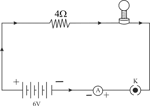Subject Experts Solutions for Exercise 1: SELF-ASSESSMENT TEST
Subject Experts Science Solutions for Exercise - Subject Experts Solutions for Exercise 1: SELF-ASSESSMENT TEST
Attempt the free practice questions from Exercise 1: SELF-ASSESSMENT TEST with hints and solutions to strengthen your understanding. Xamidea COMPLETE COURSE SCIENCE Class X solutions are prepared by Experienced Embibe Experts.
Questions from Subject Experts Solutions for Exercise 1: SELF-ASSESSMENT TEST with Hints & Solutions
Why is an ammeter connected in series in an electric circuit?
A wire of resistivity ρ is stretched to twice its length. What will be its new resistivity?
Why is parallel arrangement used in domestic wiring?
What is electrical resistivity of a material? What is its unit? Describe an experiment to study the factors on which the resistance of conducting wire depends.
Three bulbs each having power P are connected in series in an electric circuit. In another circuit another set of three bulbs of same power are connected in parallel to the same source. Will the bulbs in both the circuits glow with the same brightness? Justify your answer.
Three bulbs each having power P are connected in series in an electric circuit. In another circuit another set of three bulbs of same power are connected in parallel to the same source. Now let one bulb in each circuit get fused. Will the rest of the bulbs continue to glow in each circuit? Give reason.
Three bulbs each having power P are connected in series in an electric circuit. In another circuit another set of three bulbs of same power are connected in parallel to the same source. Representing each bulb by a resistor, draw circuit diagram for each case.
An electric lamp of resistance and a conductor of resistance are connected to a battery as shown in the circuit. Calculate:

(a) the total resistance of the circuit,
(b) the current through the circuit,
(c) the potential difference across the (i) electric lamp and (ii) conductor, and
(d) power of lamp.
